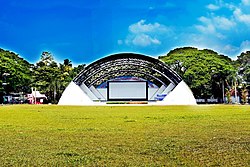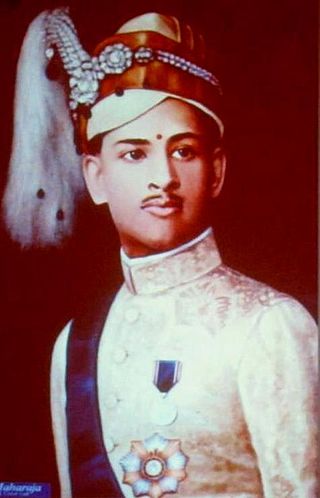
Sree Padmanabhadasa Sree Chithira Thirunal Balarama Varma, popularly known as Sree Chithira Thirunal, was the last ruling Maharaja of the Indian princely state of Travancore, in southern India until 1949 and later the Titular Maharajah of Travancore until 1991. His reign is known for several notable reforms that have indelible impact on the society and culture of Kerala.

The Kingdom of Cochin, named after its capital in the city of Kochi (Cochin), was a kingdom in the central part of present-day Kerala state. It commenced at the early part of the 12th century and continued to rule until 1949, when the monarchy was abolished by the Dominion of India.
Paliath Achan or Paliyath Achan is the name given to the male members of the Paliam royal family, a royal family from the Indian state of Kerala that ruled over Chendamangalam, Vypin, parts of Thrissur and regions that were under the erstwhile Kingdom of Villarvattom. The family had palaces & forts in these regions but their capital and primary residence remained in Chendamangalam. Although, they were Rajas in these areas(collectively known as the Paliam swaroopam) and pledged their obeisance to the Maharajah of Kingdom of Cochin (Kerala), they were placed above the post of the Princes of Kingdom of Cochin. This was because the Achans had held hereditary rights to the prime ministership of Cochin and effected a treaty with the Dutch East India Company(to oust the Portuguese East India Company that had control over the Kingdom of Cochin) which placed him second in position to the Maharajah of Kingdom of Cochin and sometimes exerting more power than the king.

Rama Varma Kunji pillai Thampuran (1751–1805), or Rama Varma IX, popularly known as Sakthan Thampuran, was the ruler of the Kingdom of Cochin. The current southern Indian city of Kochi was part of the erstwhile princely state of Kochi. He resided at Vadakkechira Palace in Thrissur. The city of Thrissur is referred to as the Cultural Capital of Kerala owing to its many traditional festivals and historic temples. Sakthan Thampuran is considered the architect of the city of Thrissur. The festival Thrissur Pooram was started by him.

Marine Drive, also known as APJ Abdul Kalam Marg, is a picturesque promenade in Kochi, India. It is built facing the backwaters, and is a popular hangout for the local populace. Despite its name, no vehicles are allowed on the walkway. Marine Drive is also an economically thriving part of the city of Kochi. With several shopping malls it is as an important centre of shopping activity in Kochi. Major fast food joints, including Marrybrown, DiMark, Coffee Bar are present along the walkway.

The Maharaja's College is a government college of higher education located in Kochi, Kerala. Established in 1875, it is one of the oldest colleges in India. Located in the heart of the city, the college is spread over a campus of 100,000 square metres on the banks of Vembanad Lake. Blanketed by tall and rare species of trees, its campus features is a mix of old and modern architecture and covers a total area of 19,525 m2 (210,170 sq ft), providing infrastructural facilities for the 22 departments of the college.
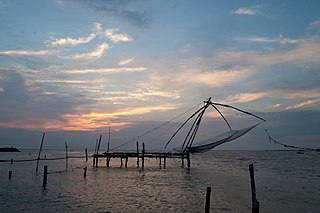
Kochi is a city located in the Ernakulam District in the Indian state of Kerala about 200 km from Trivandrum, the capital of Kerala.

Sree Kerala Varma College is a government aided college in Kanattukara, Thrissur, Kerala, India. Founded in 1947 by His Highness Aikya Keralam Thampuran, the Maharaja of erstwhile Kingdom of Cochin. Managed by the Cochin Devaswom Board, Sree Kerala Varma College is an academic institution in Kerala.

Rama Varma I often referred to as Dharma Raja, was the Maharajah of Travancore from 1758 until his death in 1798. He succeeded his uncle Marthanda Varma, who is credited with the title of "maker of modern Travancore". During his reign Dharma Raja not only retained all the territories his predecessor had gained but administered the kingdom with success. He was addressed as Dharma Raja on account of his strict adherence to Dharma Sastra, the Hindu principles of justice by providing asylum to thousands of Hindus and Christians fleeing Malabar during the Mysorean conquest of Malabar.
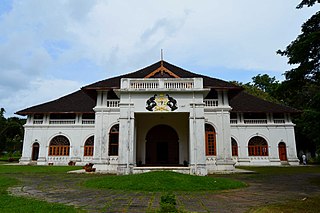
Shakthan Thampuran Palace is situated in City of Thrissur in Kerala state, India. It is named as Vadakkekara Palace, was reconstructed in Kerala-Dutch style in 1795 by Ramavarma Thampuran of the erstwhile Princely State of Cochin, well as Sakthan Thampuran is preserved by Archaeological Department. The palace was converted into a museum in 2005 by State.
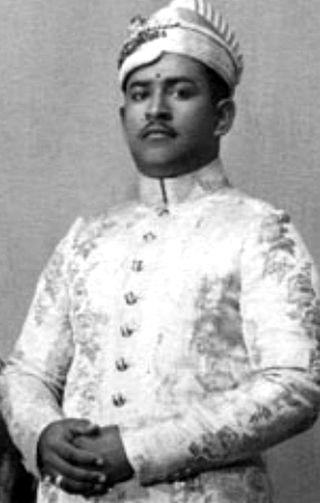
Sree Padmanabhadasa Sree Uthradom Thirunal Marthanda Varma was the titular Maharaja of Travancore. He was the younger brother of the last ruling monarch of the Kingdom of Travancore, Maharajah Chithira Thirunal Balarama Varma.

The Travancore royal family was the ruling house of the Kingdom of Travancore. They gave up their ruling rights in 1949 when Travancore merged with India and their political pension privileges were abolished in 1971. The family is descended from the Ay/Venad family and the Chera dynasty.

Vadakkechira is one of the four oldest ponds in Thrissur city of Kerala in India. It was built by Shakthan Thampuran (1751-1805) and is one of Thrissur's famous landmarks. It is owned by Cochin Devaswom Board.
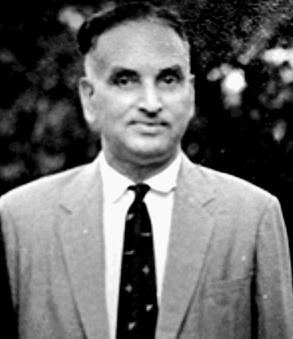
Lt. Col. P. R. Godavarma Raja, often referred to as G. V. Raja, was an Indian sports and tourism promoter and administrator, pilot, sportsman and Sanskrit scholar. He took special care in inspiring the youth into sports and was instrumental in founding the Kerala Sports Council in 1953. G. V. Raja occupied the post of Council President till he was killed in a flight mishap in 1971. G. V. Raja also played a key role in establishing the Trivandrum Tennis Club, Flying Club, and the development of the Thiruvananthapuram International Airport. As the spouse of Karthika Thirunal Lakshmi Bayi, he became the prince consort of Travancore.
The Cochin Bridge spans Lehman Creek in Cochin, Saskatchewan, Canada. Lehman Creek is a channel that connects Jackfish Lake and Murray Lake. The bridge was originally referred to as Jackfish Lake Narrows Bridge. The bridge was constructed by John Kenward based on a James Barney Marsh double arch design. The bridge served as the main entrance into Cochin as part of Saskatchewan Highway 4 until 1962 when a new bridge was constructed and the highway realigned. The bridge continued to serve local traffic until 1989 when it became a pedestrian only bridge.
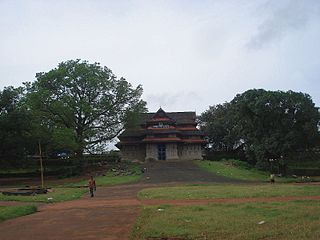
Thekkinkadu Maidanam is situated in the middle of Thrissur city of Kerala state in India. This hillock which seats the Vadakkumnathan Temple, is an open ground in the centre of the Thrissur city which is under the custody of the Cochin Devaswom Board (CDB). It hosts the spectacular cultural festival Thrissur Pooram, which is considered the Mother of all Poorams in Kerala.
Park Avenue is a famous tree-lined road starting from the western end of Durbar Hall Road to Broadway in the city of Kochi, India. Two large parks, Subhash Bose Park and Indira Priyadarshini Park are situated along the road, hence the name. Several famous historical buildings are also located alongside the road. The road has more than 45 flowering trees planted on both sides, forming a thick canopy over the road. This 1.5 km stretch was considered to be a model road for the city and the road extends further north as Shanmugham Road.
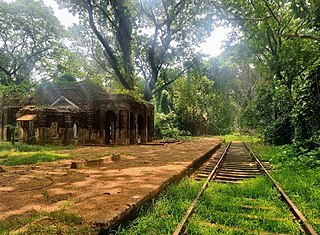
Ernakulam Terminus, also called as Ernakulam Goods Station or Ernakulam Old Station, is an abandoned railway station in the Indian city of Kochi, Kerala. It is one of the first railway station in Kochi, built by the Maharaja Rama Varma XV of Kochi. The first passenger trains started service from the station on 16 July 1902. The station lost its prominence with the commissioning of Ernakulam Junction railway station in 1932 and Cochin Harbour Terminus in 1943. Though a few passenger-trains used to halt at the old station till the 1960s, it was ignored with the passage of time and was abandoned in 1990. Many historical figures like Mahatma Gandhi, Swami Vivekananda and Rabindranath Tagore have visited Kochi through this station.
Rama Varma Kochaniyan Thampuran was an Indian royal, who was the Valiya Thampuran or oldest male member of the Cochin Royal Family. He was also a cricketer and tennis player. His widow Sarada Mani is the granddaughter of Ravi Varma V. He was one of the longest-lived members of any royal family.
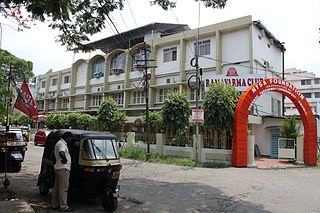
Rama Varma Club is a social club located in Kochi in the South Indian state of Kerala. Founded in 1897, it is one of the oldest social clubs in Kerala and South India. The club has traditionally been renowned for its tennis and billiards facilities. It has hosted several tennis and billiards competitions at the district and state levels.
